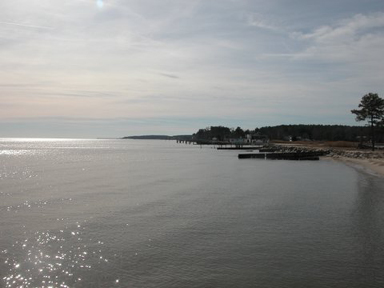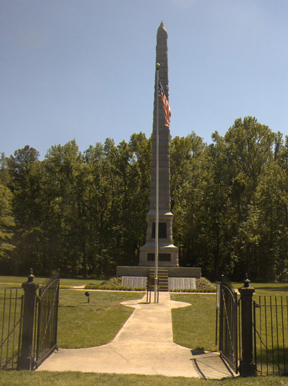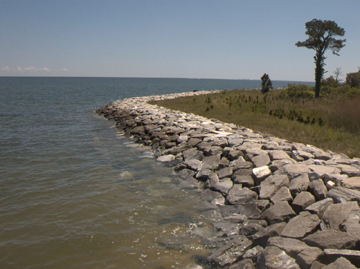 If you
are in the Washington, D.C., area this summer, consider
taking a drive down south, to the southernmost point on Maryland's western shore
to be exact. Here, you will find a treasure trove of interesting geology, as
well as spots rich in colonial and Civil War history.
If you
are in the Washington, D.C., area this summer, consider
taking a drive down south, to the southernmost point on Maryland's western shore
to be exact. Here, you will find a treasure trove of interesting geology, as
well as spots rich in colonial and Civil War history.Located in historic St. Mary's County, Point Lookout, Md., is about 70 miles south of Washington, D.C. Reaching Point Lookout by car from I-95, via the capital Beltway, is a 75-minute drive. You'll also use Route 5 and Route 235 through scenic and historic southern Maryland.
Point Lookout, Md., has beautiful coastlines along the Chesapeake Bay, where recreational opportunities abound, including boating and fishing. The region has a rich geologic and cultural history. All photos by John Rowland.
Point Lookout is the site of the confluence of the Potomac River and Chesapeake Bay. Along the drive south, you will see fields, ponds, marshes, creeks and farmland where corn, soybeans, wheat, and tobacco are the traditional crops. The region is also renowned for its bounty of shellfish, especially the blue crab. And St. Mary's County is also home to a substantial population of Amish, where horse-drawn buggies are common, especially near the Amish farmer's market. In addition, several excellent marinas are available, as well as opportunities for "Skipjack" tours and fishing boat charters.
The region has a colonial history going back to March 1634, with the settlement of Maryland that began with the arrival of passengers from England at St. Clement's Island in southwestern St. Mary's County. The 134 settlers, led by Lord Leonard Calvert, arrived ashore on March 25, 1634, after sailing from the Isle of Wight on the ships the Ark and the Dove. March 25 has become known as "Maryland Day." Once you get to Point Lookout, you can see the remainder of one of the three large manors owned by Lord Calvert.
 Prior to
the U.S. Civil War, Point Lookout was a beach resort providing a relatively
easy escape from Washington, D.C. During the war, in 1862, the U.S. government
established a hospital to help treat the mounting number of war casualties.
By 1863, the camp and hospital began to accept POWs. The numbers swelled over
the next two years to more than 52,000. Tragically, nearly 4,000 Confederate
POWs died from disease by 1865 at Point Lookout. The monument in the small park
at the side of Route 5 at Point Lookout citing their names and home states represents
the only instance of a federal monument to honor Confederate soldiers.
Prior to
the U.S. Civil War, Point Lookout was a beach resort providing a relatively
easy escape from Washington, D.C. During the war, in 1862, the U.S. government
established a hospital to help treat the mounting number of war casualties.
By 1863, the camp and hospital began to accept POWs. The numbers swelled over
the next two years to more than 52,000. Tragically, nearly 4,000 Confederate
POWs died from disease by 1865 at Point Lookout. The monument in the small park
at the side of Route 5 at Point Lookout citing their names and home states represents
the only instance of a federal monument to honor Confederate soldiers.Point Lookout is now most famous for its hardhead, blues, rockfish, trout and flounder. Be sure to check out the local fishing piers and recreational swimming areas. Also, make a trip to the Point Lookout Lighthouse, which was active for 135 years until 1965, when the U.S. Navy purchased the property and automated the light. Since then, the property has gained notoriety as a haunted site. Numerous visitors to the area have claimed encounters with "spirits," some of which are attributed to deceased Civil War soldiers or Laura Berg, a light keeper at the station. Point Lookout State Park holds a very popular "Ghost Walk" for the public in late October.
A federal monument in a small park along Route 5 in Point Lookout, Md., honors Confederate soldiers, who were held as POWs in the region during the Civil War. It is the only
federal memorial in the United States for Confederate soldiers.
While looking for ghosts and eating fish, however, do not forget about the region's interesting geology. Southern Maryland, including St. Mary's County, is the "coastal plain." Due to low topographic relief and a high groundwater table, wetland areas are common throughout the area. Forested wetlands are found on floodplains along the freshwater tidal and nontidal streams, in upland depressions, and in broad flat areas. The wetlands provide flood buffering, erosion control, bank stabilization and water-quality improvement, as well as a great spot for wildlife watching.

 The broad
expanse of water off Point Lookout provides ample opportunity for a storm coming
up the bay to develop a formidable fetch prior to landfall on the western shore.
Hurricane Isabel struck the area in September 2003 causing substantial damage
to trees, bulkheads, piers and beaches, and even turning up new fossils, including
a giant whale (see
The broad
expanse of water off Point Lookout provides ample opportunity for a storm coming
up the bay to develop a formidable fetch prior to landfall on the western shore.
Hurricane Isabel struck the area in September 2003 causing substantial damage
to trees, bulkheads, piers and beaches, and even turning up new fossils, including
a giant whale (see 